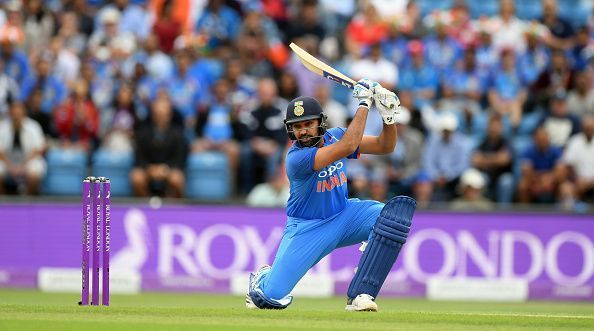
Rohit Sharma's consistency in the shorter formats - A Statistical Analysis
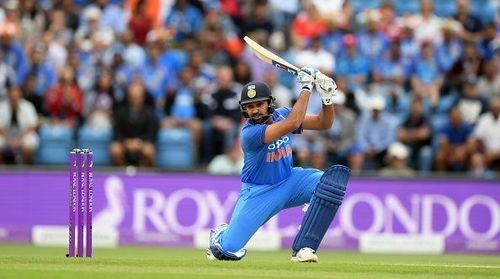
All athletes and sportspersons have that one special person whom they are indebted to at almost every stage of their career, be it their family, friends or their coaches. Among many players who owe a lot of their success to MS Dhoni, one of them is a certain Rohit Sharma.
His transformation as a batsman was nothing less than a fairytale after he was promoted by Dhoni to the opening slot in early 2013. Over the next 5-6 years, he has piled on a mountain of runs and broken several records.
But despite all that, there has always been this never-ending debate on his consistency in the shorter formats. While some believe that being the second-highest run getter since 2013 cannot come without consistency, there are others who have voiced that he either scores big or doesn’t score at all. This article would analyze Rohit’s consistency in the shorter formats over the past six years and hopefully provide an answer to the debate
How can consistency be measured?
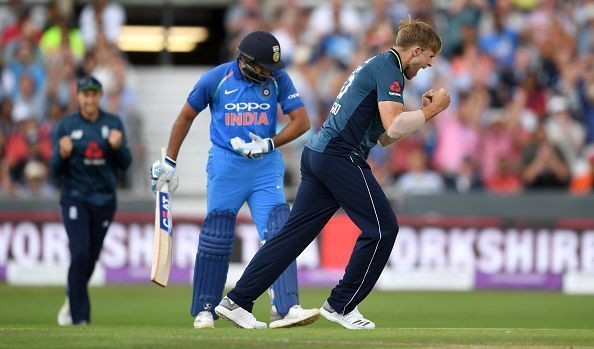
A batsman is termed consistent if his scores often fall within a certain range (eg. 40-70). On the other hand, if his scores are at the extremes quite frequently he is termed inconsistent. Until now, there hasn’t been a proven way to measure the consistency of a batsman, like the way average decides the worth of a top order batsman.
A parameter that can describe consistency is the number of innings required to cross a landmark score (say 50). But on the occasions the player didn’t cross the landmark score, this parameter fails to explain whether he was still consistently getting runs or getting out cheaply.
So, apart from this, there is a need for some other mathematical parameter that can describe the consistency of a batsman. Enter Standard deviation (SD) to the rescue. It is basically a parameter which basically calculates the amount by which each value among a set of values deviates from the mean of all the values. Higher the deviation of each of the values from their mean, higher would be the Standard Deviation.
Let us take an example of a Player A who has amassed scores of 30,50,45,55 and another player B who has scores of 10,90,80,0 but both end up averaging 45. The difference between the individual scores and their average would be much higher for Player B compared to A. Hence, Player B would have a much higher value of SD compared to Player A.
A consistent batsman should have a lower SD as most of his scores would be concentrated about his average. Likewise, the SD would be high for an inconsistent player because his scores would be quite far off from his average. But, this poses a small problem too. A player who has scores of 5,7,8,10,12,4 would also have a low value of SD and would be considered consistent on mathematical terms. But in cricket, he is nowhere close to being called a consistently good player.
So, we need a parameter that combines both SD and Average of a player. A custom index can be created called the Consistency Index (CI) which can be calculated by dividing the Standard Deviation by Average (CI=SD/Average). But because we are focusing on the shorter formats, the Strike Rate also needs to be incorporated into the denominator part in the formula. So, weights should be allocated for Average and SR depending on the format. So, the final formula would be as follows:

Lower the value of Consistency Index, more consistently well the batsman has performed (Low SD, High Strike Rate and high Average) and vice versa. We can’t determine consistency just based on the absolute value of CI because we can’t fix a benchmark value, below which a player can be termed consistent and so on.
But multiple batsmen can be compared with this value and that way, consistency can be measured. For example, if the CI of a player is close to someone like Kohli, then we can conclude that the player in question has been almost as good as Kohli, if not as good. So, this parameter would be employed to analyze Rohit’s consistency aspects.
Note: ODI and T20 Stats updated as of November 1, 2018
Rohit's consistency in ODIs
The Consistency Index values have been calculated for the top 15 ODI batsmen based on both runs and average using the first formula and given below.
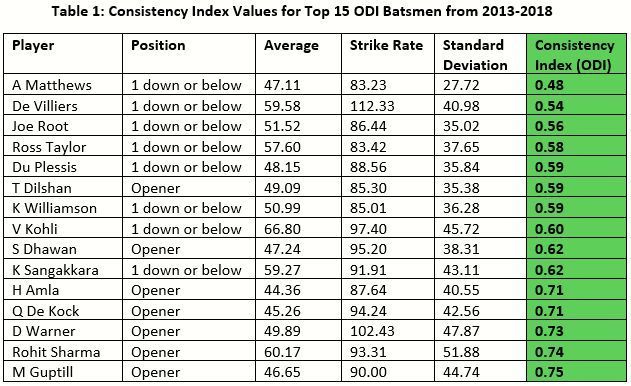
The first noticeable observation is how there has been a segregation of sorts between the openers (higher CI value) and the batsmen coming after them (lower CI value). A possible reason for this could be the fact that the new ball swings only for about 5-6 overs at the start. This exposes the openers to the swinging ball more than the change batsmen.
While we have the likes of Kohli, Root, Williamson, De Villiers, Du Plessis, etc almost on the same level (0.5-0.6), most of the openers like Rohit, Warner, Amla are on comparable terms (0.7-0.75) but with CI values slightly lesser than the others.
So, Rohit’s consistency has been almost on the same level as that of Amla, Warner, De Kock and Guptill. Amla has shown tremendous consistency in the past few years by breaking several ODI records, and De Kock has shown tremendous growth over the past 4–5 years. Guptill and Warner have also been very consistent and destructive run-getters for their respective countries. So, we can conclude that Rohit Sharma has also been quite consistent for India in ODIs in the last few years.
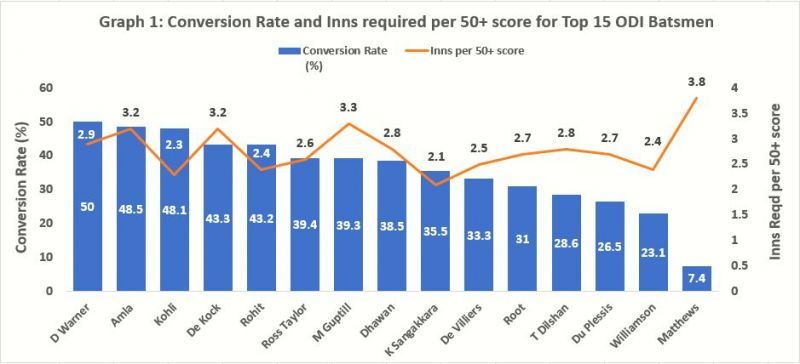
From the above graph, we can see that Rohit’s conversion rate of 43.2% (19 centuries/44 fifty+ scores) is the 5th best among the top 15 ODI batsmen. Plus, three of the four batsmen above him in that parameter took slightly more innings to reach a 50 compared to him.
So, Rohit has been impressive in all three aspects, which is enough to conclude that he has been not only been consistently scoring runs but also racking up the big ones in ODIs in the last few years. But, it must be stated that he has a long way to go to challenge the likes of Kohli, Root, Williamson, etc.
Rohit's consistency in T20Is
The Consistency Index values have been calculated for the top 15 T20I batsmen based on runs, strike rate and average combined using the second formula and given below.
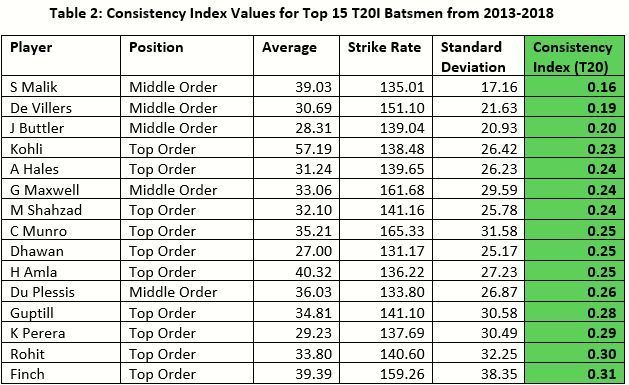
Here, the CI values are much closer to each other, unlike the ODI values which were sort of segregated into two categories. Rohit’s consistency here is comparable to that of T20 specialists like Guptill, Finch and Kusal Perera.
Guptill and Finch have not only been consistent run-scorers for their respective countries but have even dominated many bowling attacks in the shortest format. Last year, Finch became the second fastest to 1000 T20I runs after Kohli and Guptill is currently the all-time leading run-scorer in this format. So, their dominance and consistency doesn’t even have to be proven.
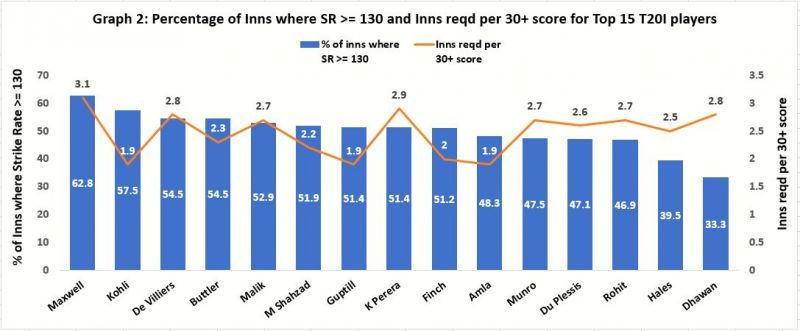
A good innings in T20 for a top order batsman would be to score at least 30 runs at a strike rate of at least 130. Looking at the parameter percentage of innings with SR >= 130, Rohit is almost right up there with the other destructive openers like Shahzad, Munro, Guptill, Finch, etc which is quite impressive.
The number of innings taken by him per 30+ score also is quite decent as it is on par with that of Munro, Hales, Du Plessis, though it is nowhere near the likes of Shahzad, Kohli, Finch. The above three parameters combined prove that Rohit has been quite consistent in the shortest format too and has been time and again giving good, quick starts for the team when required.
To sum up the analysis, it is quite clear that Rohit Sharma has turned out to be a consistent opener for the men in blue ever since 2013 in the shorter formats of the game. If Rohit really was just a flat-track bully or a minnow-basher, like his critics make him to be, such consistency would be tough to achieve.
Plus, he has tremendous numbers in Australia, England and against quality bowling attacks like Australia, England and Pakistan. Apart from them, he has also tasted decent success against and in New Zealand. These facts are enough to prove his worth as an opener in limited overs cricket.
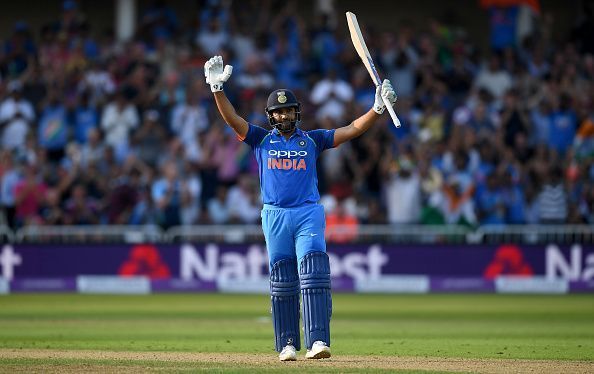
But, it also must be said that he is not quite at the level yet where he can be termed as one of the greats of the game, like Kohli. Though he hasn’t shown the same degree of consistency in the Test format, his selection for the Australia series might just prove to be a masterstroke as the pitches down under might just suit his style of batting.
If the Hitman can make use of his chances there, it would surely be a treat to everyone’s eyes because when he is in full flow, there are few players who can be as imposing as him at the crease.